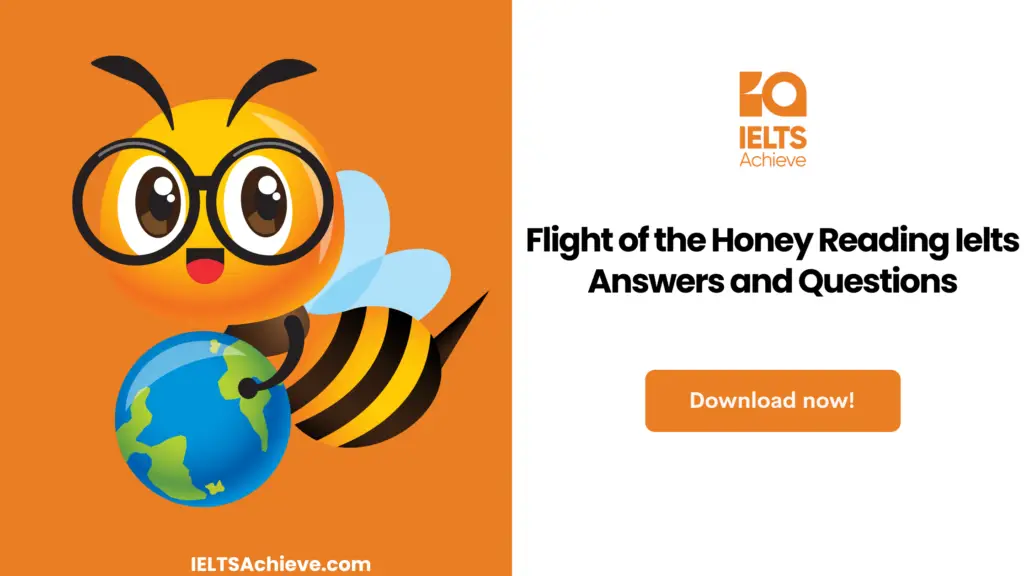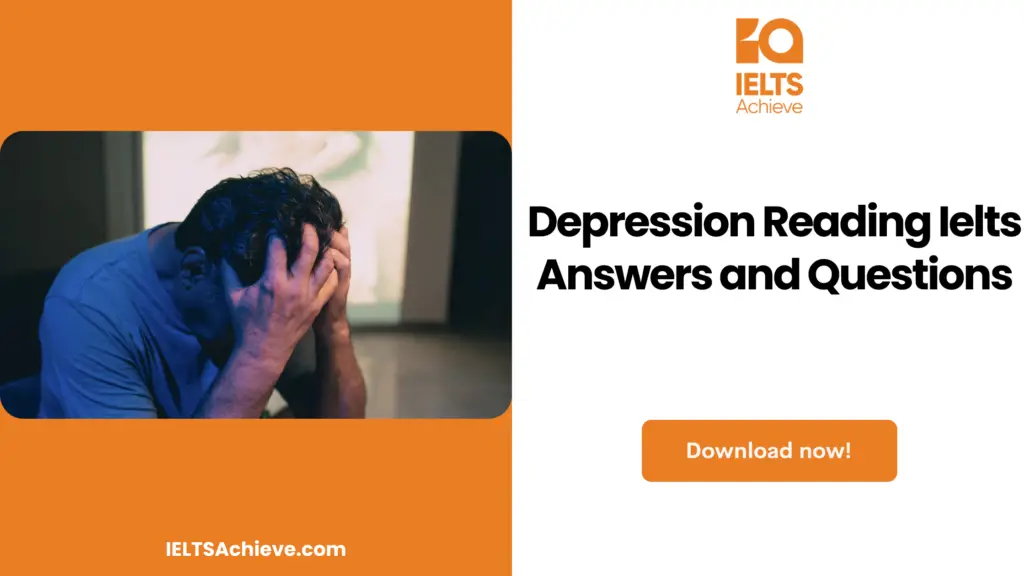The Blog post contains the following IELTS Reading Questions:
- IELTS Reading Multiple Choice Question.
- IELTS Reading Sentence Completion.
- IELTS Reading True False Not Given.
Stay informed and prepared for success – Explore our comprehensive Reading Test Info page to get valuable insights, exam format details, and expert tips for mastering the IELTS Reading section.
IELTS Reading Passage – Flight of the Honey

Flight of the Honey
A Honeybees are distinguished by their ability to make liquid sugar (honey) and their propensity to build wax nests in colonies, both of which require a high level of social interaction among members. As a result, they maintain strict gender-based divisions of labour, with all males working as drones to fertilize and care for the eggs, and all females, except for the one fertile queen, tasked with gathering nectar for the colony’s offspring. In addition, honeybees have developed a complex system of communication to send vital information from one individual to another.
B Perhaps the most remarkable characteristic of honeybee communication is a set of flight motions only performed by a female worker bee that has returned to the nest with nectar and needs to alert the rest of her colony that she has discovered food supplies and where they can be found. Karl von Frisch, a German zoologist, first interpreted this so-called honeybee dance in the early 1970s. For the purpose of observation, von Frisch and his students built several glass-walled hives and marked a collection of worker bees, or foragers, with paint. When the bees returned, he meticulously recorded their movements, the angle and direction of their flight, and any other visual cues offered by the colony. Von Frisch discovered that each element of the dance revealed specific information about the location of the nectar reserves and enticed others to revisit the site.
C The distance from the field to the hive is the first piece of information transmitted by dancing bees, which they do in one of three ways. If it is fewer than 50 meters from the colony’s nest, the bee will fly in tight circles before abruptly changing direction. She will repeat this routine, which von Frisch’s team referred to as the round dance until she has recruited multiple employees to return to the field with her. When the distance exceeds 50 meters but is less than 150 meters, she will do a sickle dance, a flight pattern like a crescent. If the field is more than 150 meters away, the forager will perform a waggle dance consisting of a brief run straight ahead followed by a return to her original position. She will then retrace her steps and return from the opposite side. The length of the forward run corresponds to the distance of the food source; for instance, a 2.5-second forward run implies that the nectar was located approximately 2500 meters away.
D Recruits must also know the direction in which they must fly to reach the suitable foraging spot; this information is sent to the hive via the bee’s orientation. It is not, however, a direct correlation with the position of the hive’s food supply, but rather its positioning relative to the sun. Therefore, if the food is located directly opposite the sun, the bee will fly straight down; if it is in the same direction as the sun, it will fly straight up from the colony nest. A position of 60 degrees to the right of the sun will cause the bee to descend at an angle of 60 degrees to the right of the nest. In addition, because the sun is in constant motion throughout the day, the bee’s orientation will change depending on when the dance is done. However, sceptics of von Frisch’s results argue that visual signals are insufficient to indicate the exact location of a food source. Several scientists, including Adrian Wenner, believe that odour is one of the factors along with dance for honeybee communication. Wenner was unable to attract fresh workers to the foraging activities using robotic bees performing the same dances; but, when he gave nectar to the robot, workers readily followed. Additionally, he determined that the odours must be indicative of the actual flowers that hold the food source; otherwise, the bees will arrive at the place without knowing which blooms will be beneficial.
Unlock your full potential in the IELTS Reading section – Visit our IELTS Reading Practice Question Answer page now!
Recommended Questions:
Renewable Energy IELTS Reading Question with Answer
Flight of the Honey Reading Questions
Question 1-3
Refer to the Reading Passage and choose the option that best completes each sentence.
01. Studies undertaken in the 1970s
A. were conducted using conventional beehives.
B. found that forager bees had distinctive markings.
C. The phenomenon of the honeybee’s body language has been thoroughly examined.
D. The conclusion was that there was no visible pattern to the bees’ movement.
02. To determine the proximity of a nectar supply, forager bees use their sense of smell.
A. will continue to fly in the same direction.
B. only begins to move when other bees are present and watching.
C. will proceed straight ahead.
D. will repeatedly fly in one direction and then abruptly reverse course.
03. Honey Bees
A. possess a basic ability to convey information.
B. have clearly separated functions.
C. exist in equal numbers of male and female individuals.
D. relocating frequently to regions with particular sorts of flowers.
Ready to improve your performance in Multiple Choice Questions (MCQs)? Click here to access our comprehensive guide on how to tackle MCQs effectively in the IELTS Reading section.
Question 4-8
Complete the sentence below. Write NO MORE THAN TWO WORDS AND/OR NUMBER from the passage for each answer.
04. The bee will advance _____________ for every 1,000 meters the food source is away.
05. For food sources more than 150 meters away, the forager will do a _______________ dance to communicate distance.
06. It has been suggested that both ______________ and mobility can aid in locating food sources.
07. To locate the direction of the nectar, the forager will travel in accordance with ______________ position.
08. Von Frisch used a variety of __________ cues to determine how bees communicate.
Enhance your sentence completion skills in the IELTS Reading section. Click here to access our comprehensive guide and learn effective strategies for filling in missing words or phrases in sentences.
Question 9-13
Do the following statements agree with the information given in the reading passage? In boxes 9 -13 on your answer sheet write
TRUE, if the statement agrees with the information
FALSE, if the statement contradicts the information
NOT GIVEN, if there is no information on this
09. Sunlight is required for the honeybee dance to be performed.
10. The honeybee dance is performed until a sufficient number of additional bees join the nectar harvest.
11. Wenner determined that a similar odour will aid bees in locating the general region of nectar, but not the precise source.
12. Drone bees communicate by a series of complex actions.
13. Von Frisch noticed that each part of the dance disclosed precise information regarding the location of the nectar deposits and encouraged others to return to the site.
Enhance your skills in identifying information as True, False, or Not Given. Click here to discover expert strategies and techniques for mastering this question type in the IELTS Reading section.
Unlock your full potential in the IELTS Reading section – Visit our IELTS Reading Practice Question Answer page now!
Recommended Questions:
Renewable Energy IELTS Reading Question with Answer
Flight of the Honey Reading Answers
1. C
2. D
3. B
4. One Second
5. Waggle
6. Odour
7. The sun’s
8. Visual
9. Not Given
10. True
11. False
12. False
13. True

We hope you found this post useful in helping you to study for the IELTS Test. If you have any questions please let us know in the comments below or on the Facebook page.
The best way to keep up to date with posts like this is to like us on Facebook, then follow us on Instagram and Pinterest. If you need help preparing for the IELTS Test, join the IELTS Achieve Academy and see how we can assist you to achieve your desired band score. We offer an essay correction service, mock exams and online courses.

